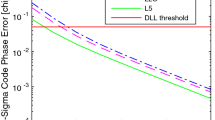Abstract
Much of the research into multipath detection and mitigation has not considered the carrier phase delay between the line of sight (LOS) and reflected signals. A new variable referred to as early late phase (ELP) has recently been proposed to exploit this phase difference. It has been found that in a receiver tracking the L1 GPS signal, the probability of detecting multipath is lower when the carrier phase difference between the LOS and a reflected signal is an integer multiple of π. Since the pseudorange error caused by the multipath’s presence is the highest in this case, we propose to exploit the coexistence of another GPS civilian signal, the L2C. We present an analysis of ELP for the L1 and L2C signals, and a combination of both, for detecting multipath. The multipath detection performance has been compared using probabilities of false alarm and detection. An ideal algorithm should have lower probability of false alarm and higher probability of detection. However, it has been found that using dual-frequency ELP increases both probabilities. Thus, receiver operator characteristics (ROC) curves, and the area under the ROC curves, have been used for effective comparison. It has been found that the L2C signal individually gives worse performance than L1 because of its weaker signal strength. However, the combination of L1 and L2C gives the best overall performance, and thus it can be claimed that ELP using dual-frequency receivers is a more effective approach for detecting multipath.












Similar content being viewed by others
References
Borre K, Akos D, Bertelsen N, Rinder P, Jensen SH (2006) A software-defined GPS and Galileo receiver: single-frequency approach. Birkhäuser, Boston
Bradley AP (1997) The use of the area under the ROC curve in the evaluation of machine learning algorithms. Pattern Recogn 30(7):1145–1159
Dierendonck AJV, Fenton P, Ford T (1992) Theory and performance of narrow correlator spacing in a GPS receiver. J US Inst Navig 39(3):265–283
Fenton PC, Jones J (2005) The theory and performance of NovAtel Inc.’s vision correlator. 18th International Technical Meeting of the Satellite Division of the US Institute of Navigation, Long Beach, California, 13–16 September, pp 2178–2186
Fukunaga K (1990) Introduction to statistical pattern recognition, 2nd edn. Academic Press, San Diego
Hatch RR, Knight J, Dai L (2007) Recent GNSS developments at NavCom Technology. International Global Navigation Satellite Systems Society (IGNSS) Symposium, Sydney, Australia, 4–6 December, paper 45, CD-ROM procs
Lau L, Cross PA (2006) A new signal-to-noise-ratio based stochastic model for GNSS high-precision carrier phase data processing algorithms in the presence of multipath errors. 19th International Technical Meeting of the Satellite Division of the Institute of Navigation, Fort Worth, Texas, 26–29 September, pp 276–285
Mubarak OM (2008) Analysis of early late phase for multipath mitigation. 21st International Technical Meeting of the Satellite Division of the US Institute of Navigation, Savannah, Georgia, 16–19 September, pp 669–678
Mubarak OM, Dempster AG (2007) Carrier phase analysis to mitigate multipath effect. International Global Navigation Satellite Systems Society (IGNSS) Symposium, Sydney, Australia, 4–6 December, paper 64, CD-ROM procs
Mubarak OM, Dempster AG (2008) Differential early late phase for multipath detection at critical Doppler offsets. International Symposium on GPS/GNSS, Yokohama, Japan, 25–28 November, pp 939–946
Mubarak OM, Dempster AG (2009) Performance comparison of ELP and DELP for multipath detection. 22nd International Technical Meeting of the Satellite Division of the US Institute of Navigation, Savannah, Georgia, 22–25 September
NAVSTAR Global Positioning System Interface Specification IS-GPS-200 revision D, 7 March 2006
Qaisar SU (2009) Performance analysis of Doppler aided tracking loops in modernized GPS receivers. 22nd International Technical Meeting of the Satellite Division of the US Institute of Navigation, Savannah, Georgia, 22–25 September
Qaisar SU, Dempster AG (2008) Cross-correlation performance comparison of L1 & L2C GPS codes for weak signal acquisition. International Symposium on GPS/GNSS, Yokohama, Japan, 25–28 November, pp 692–700
Townsend B, Fenton P (1994) A practical approach to the reduction of pseudorange multipath errors in a L1 GPS receiver. 7th International Technical Meeting of the Satellite Division of the US Institute of Navigation, Salt Lake City, Utah, 20–23 September, pp 143–148
Townsend B, Wiebe J, Jakab A (2000) Results and analysis of using the MEDLL receiver as a multipath meter. US ION National Technical Meeting, Anaheim, California, 26–29 January, pp 73–79
Tran M (2004) Performance evaluations of the new GPS L5 and L2 civil (L2C) signals. J US Inst Navig 51(3):199–212
Tran M, Hegarty C (2002) Receiver algorithms for the new civil GPS signals. US ION National Technical Meeting, 28–30 January 2002, San Diego, California, pp 778–789
Acknowledgments
This research is supported by Australian Research Council Linkage Project LP0668907.
Author information
Authors and Affiliations
Corresponding author
Rights and permissions
About this article
Cite this article
Mubarak, O.M., Dempster, A.G. Analysis of early late phase in single-and dual-frequency GPS receivers for multipath detection. GPS Solut 14, 381–388 (2010). https://doi.org/10.1007/s10291-010-0162-z
Received:
Accepted:
Published:
Issue Date:
DOI: https://doi.org/10.1007/s10291-010-0162-z




